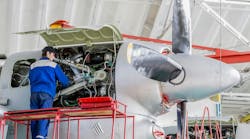Aircraft maintenance stands aren’t typically “one size fits all.”
But, for about a year now, WAAG has offered stands to access windshields of either all narrow bodies or all wide bodies. The Narrow-Body Windshield Repair Stand (#60225) has a deck that adjusts from 132 to 190 inches, while the Wide-Body Windshield Repair Stand (#60223) has a deck that adjusts from 163 inches to 220 inches. Both stands have an overall footprint of 272 inches (length) by 144 inches (width). Adjustments are made using an ergonomic lifting handle to raise or lower the deck with little effort and no hydraulics, and the stands have stops at 3-inch increments.
The counter-balanced deck adjusts to fit either all narrow-body aircraft or all wide-body aircraft. Adjustable deck slats that lock at 2-inch increments allow precise fitting. Areas of the stand that may touch the aircraft are lined using rubber guards to prevent damage, including scratches.
Stephanie Brägger, WAAG sales/office manager, says what inspired the design of the narrow- and wide-body windshield repair stands was what has inspired most of the company’s products: demand from ground handlers and aircraft maintenance technicians. “In this case, we needed one stand to fit multiple aircraft,” she says.
Before, WAAG had only a 13-foot (156-inch) fixed height windshield replacement stand. Customers used that stand or any stand that could reach, but they weren’t designed to do windshield repair safely.
“Safety is the No. 1 concern – especially when reaching these heights,” Brägger says. “Employees need to be able to safely work at a specific height without making their ‘own attempt’ to reach or access areas along the windshield.”
WAAG includes hooks that are welded on so operators can “click in” their harnesses for added safety. For an additional fee, fall protection grids can be added to any stand, stairway or deck.
Prior to the narrow- and wide-body repair stands, she says, “We also received feedback that our competitors’ stands were too bulky to move around.” Subsequently, she says, “Both our narrow-body and wide-body windshield stands are easily positioned, maneuverable and safe for the employee and the aircraft.”
WAAG, on its website says one person can operate most stands, which have two main solid rubber wheels (16 inches by 4 inches) with heavy-duty axles and hubs, and two polyurethane-over-steel wheels (8 inches by 2 inches) with precision bearings and heavy-duty KPL swivels. A heavy-duty tow bar comes standard on both stands.
With all WAAG stands, tubular wheel chocks come standard in addition to single-action, lever-actuated plunge brakes. Pull back the lever and the stand is locked in place.
Overall construction is heavy-duty steel. Durability is further added through cross bracing. Heavy wall 1.5-inch round steel tubing is mounted to the stair rail in two places at the lower end. The design creates a very sturdy stand, she says.
The stairs are OSHA-compliant forward ascent and descent, and the steps are galvanized steel Grip Strut with a safety yellow leading edge. On the deck itself, Brägger says regular Grip Strut panels have been replaced with Traction Tread panels, allowing for a more comfortable surface to kneel, or lay or place the windshield on during the replacement process.
For customers who want to stay on brand, make sure their WAAG equipment is distinguishable from other WAAG equipment nearby or don’t care for safety orange, WAAG offers a choice of powder-coated colors for the first coat. The second powder coat is UV-resistant clear.
In addition to being customizable and easily manuevered, Brägger says WAAG stands are preferred because there’s no hydraulic cylinders, fuel, or battery cell to maintain.
Stands are shipped in three pieces: upper body, lower body and deck. Assembly takes about 2 hours. WAAG also offers a complete line of stands for all current aircraft.





